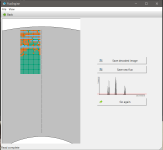ethump
Experienced Member
Hi -
I've picked up another Apple II Europlus. If you look back at my posts on here you'll see me battling another Europlus. I still have that one and I intend to use the new one to try find out what's wrong with the old one. Before I do that though I want to have a good play with this new one since I've never really had (a working) one before.
My question here is to do with disks and what I can expect from a Greaseweazle/Fluxengine setup. I was under the impression the Apple II used GCR encoding. When I download disk images like this AppleDOS one, and open it in the Floppy Disk Emulator, it decodes as FM. Seems to work fine in an Apple II emulator though. I seem to be able to write the DSK just fine (using a 40 track 5.25" drive) but it doesn't work when I try boot the Apple II from it.
I can do a "fluxengine read apple2 shugart_drive" from a known working physical Apple DOS 3.3 disk and then write it out to a blank just fine. That .dsk also decodes as an FM disk. If I force the Apple II decode, I see nothing sensical. The .dsk I created from my known working disk and the .dsk from that archive.org file look similar in terms of file size, and their representation in FloppyDiskEmulator both seem pretty similar. I've tried to write out a few other .dsk files too, none work.
So, I'm not sure what's going on. Is this consistent? If so, why? or am I doing something goofy?
cheers!
e
I've picked up another Apple II Europlus. If you look back at my posts on here you'll see me battling another Europlus. I still have that one and I intend to use the new one to try find out what's wrong with the old one. Before I do that though I want to have a good play with this new one since I've never really had (a working) one before.
My question here is to do with disks and what I can expect from a Greaseweazle/Fluxengine setup. I was under the impression the Apple II used GCR encoding. When I download disk images like this AppleDOS one, and open it in the Floppy Disk Emulator, it decodes as FM. Seems to work fine in an Apple II emulator though. I seem to be able to write the DSK just fine (using a 40 track 5.25" drive) but it doesn't work when I try boot the Apple II from it.
I can do a "fluxengine read apple2 shugart_drive" from a known working physical Apple DOS 3.3 disk and then write it out to a blank just fine. That .dsk also decodes as an FM disk. If I force the Apple II decode, I see nothing sensical. The .dsk I created from my known working disk and the .dsk from that archive.org file look similar in terms of file size, and their representation in FloppyDiskEmulator both seem pretty similar. I've tried to write out a few other .dsk files too, none work.
So, I'm not sure what's going on. Is this consistent? If so, why? or am I doing something goofy?
cheers!
e



